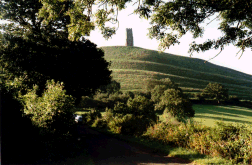Shewy
& Ian's English Life
Glastonbury Tor
|
For the pilgrim the landscape of Avalon is a treasure trove where sacred sites abound. The most obvious to the visitor is Glastonbury Tor which can be seen from a great distance rising enigmatically above the flat Summerland meadows. There are many myths and legends associated with the Tor - it is the home of Gwyn ap Nudd, the Lord of the Underworld, and a place where the fairy folk live.
|
 |
Over the last few years there has been discussion about the significance of the terracing of the Tor. It was proposed first by Geoffrey Russell and then expanded on by Geoffrey Ashe, the well-known Arthurian scholar, that the terracing on the slopes of Glastonbury Tor is the remains of a great three-dimensional neolithic labyrinth, a ceremonial way dedicated to the ancient British Goddess.
Whether it will ever be proved that the labyrinth was constructed in the neolithic era or not is a matter for future archeology, but since it was first suggested many thousands of people have walked it in a sacred manner. And this is no mean feat since it takes from 4-6 hours to walk in and out of the labyrinth. It provides the perfect setting for a present day ceremonial journey whether it was or not in the past. The Tor is now owned and cared for by the National Trust and there is free access to the public at all times.
PRE-CELTIC/NEOLITHIC TIMES
Some flint tools found, a greenstone axehead burried on top of hill probably
votive offering. The terraces around the Tor may have been set up as a
labyrinth for some sacred purpose - no proof as no terrace has been
excavated or dated. No evidence of stones or structures at top of Tor.
CELTIC TIMES
Few finds in early period - some small finds in Roman occupation period (the
Romans used Glastonbury as a focus of several trade routes and may have
had an agricultural centre, like a villa near the present Abbey site). After the
Romans left the hill was settled by a small group of people in rough huts during
the period around 450-55 AD. These were probably Celtic hermits but could have
been a small garrison for one of the local Celtic kings.
SAXON TIMES
In the late Seventh century the newly Christianised Saxons took Glastonbury and
upgraded the Christian settlement there. The earliest Abbey remains date from
this time, and the Tor was settled by Saxon monks or hermits, two small cells, a
possible chapel and a cross-head were found.
MEDIEVAL TIMES
The Tor top was levelled at some point in the Tenth or Eleventh century to build
a large stone church. This removed much archaeological evidence. In 1275 this
church was felled by an earthquake. It was rebuilt smaller in 1323 and lasted
until the death of the Abbey at Henry VIII's hands in 1539. The church was
quarried for stone.
MODERN TIMES
The tower was repaired this century and is now in the hands of the National
Trust. Thousands visit it every year for as many reasons!